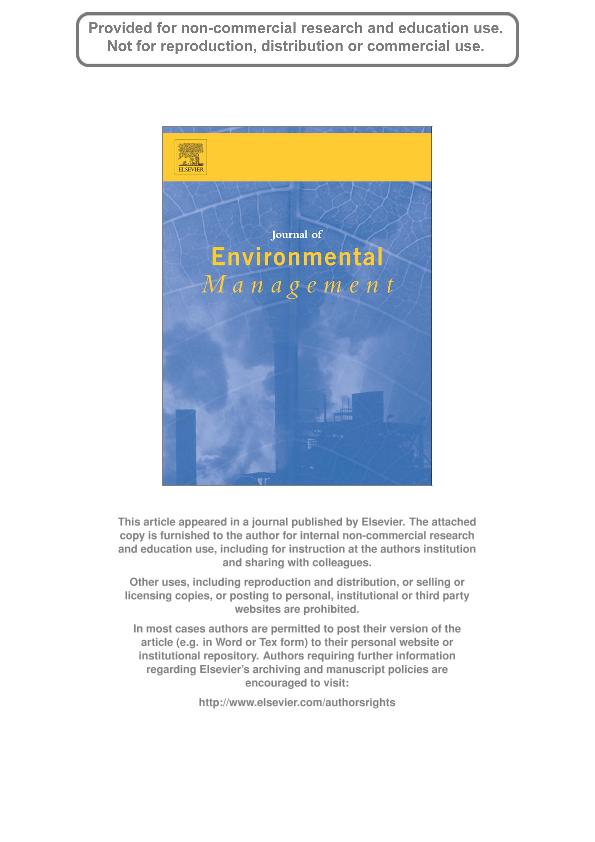Mostrar el registro sencillo del ítem
dc.contributor.author
Maine, Maria Alejandra

dc.contributor.author
Hadad, Hernán Ricardo

dc.contributor.author
Sánchez, Gabriela Cristina

dc.contributor.author
Mufarrege, María de Las Mercedes

dc.contributor.author
Di Luca, Gisela Alfonsina

dc.contributor.author
Caffaratti, Sandra Ester

dc.contributor.author
Pedro, María del Carmen

dc.date.available
2017-05-05T14:33:40Z
dc.date.issued
2013-10
dc.identifier.citation
Maine, Maria Alejandra; Hadad, Hernán Ricardo; Sánchez, Gabriela Cristina; Mufarrege, María de Las Mercedes; Di Luca, Gisela Alfonsina; et al.; Sustainability of a constructed wetland faced with a depredation event; Elsevier; Journal of Environmental Management; 128; 10-2013; 1-6
dc.identifier.issn
0301-4797
dc.identifier.uri
http://hdl.handle.net/11336/16005
dc.description.abstract
A free water surface constructed wetland (CW) designed for effluent treatment was dominated by the emergent macrophyte Typha domingensis reaching a cover of roughly 80% for 5 years. Highly efficient metal and nutrient removal was reported during this period. In June 2009, a population of approximately 30 capybaras (Hydrochoerus hydrochaeris) caused the complete depredation of the aerial parts of macrophytes. However, plant roots and rhizomes were not damaged. After depredation stopped, T. domingensis showed a luxuriant growth, reaching a cover of 60% in 30 days. The objective of this work was to evaluate the sustainability of the CW subjected to an extreme event. Removal efficiency of the system was compared during normal operation, during the depredation event and over the subsequent recovery period. The CW efficiently retained contaminants during all the periods studied. However, the best efficiencies were registered during the normal operation period. There were no significant differences between the performances of the CW over the last two periods, except for BOD. The mean removal percentages during normal operation/depredation event/recovery period, were: 84.9/73.2/74.7% Cr; 66.7/ 48.0/51.2% Ni; 97.2/91.0/89.4% Fe; 50.0/46.8/49.5% Zn; 81.0/84.0/80.4% NO3 - ; 98.4/93.4/84.1% NO2 - ; 73.9/ 28.2/53.2% BOD and 75.4/40.9/44.6% COD. SRP and TP presented low removal efficiencies. Despite the anoxic conditions, contaminants were not released from sediment, accumulating in fractions that proved to be stable faced with changes in the operating conditions of the CW. T. domingensis showed an excellent growth response, consequently the period without aerial parts lasted a few months and the CW could recover its normal operation. Plants continued retaining contaminants in their roots and the sediment increased its retention capacity, balancing the operating capacity of the system. This was probably due to the fact that the CW had reached its maturity, with a complete root-rhizome development. These results demonstrated that faced with an incidental problem, this mature CW was capable of maintaining its efficiency and recovering its vegetation, demonstrating the robustness of these treatment systems.
dc.format
application/pdf
dc.language.iso
eng
dc.publisher
Elsevier

dc.rights
info:eu-repo/semantics/openAccess
dc.rights.uri
https://creativecommons.org/licenses/by-nc-nd/2.5/ar/
dc.subject
Sediment
dc.subject
Contaminants
dc.subject
Effluent
dc.subject
Macrophytes
dc.subject
Capybaras
dc.subject
Constructed Wetlands
dc.subject.classification
Otras Ciencias de la Tierra y relacionadas con el Medio Ambiente

dc.subject.classification
Ciencias de la Tierra y relacionadas con el Medio Ambiente

dc.subject.classification
CIENCIAS NATURALES Y EXACTAS

dc.title
Sustainability of a constructed wetland faced with a depredation event
dc.type
info:eu-repo/semantics/article
dc.type
info:ar-repo/semantics/artículo
dc.type
info:eu-repo/semantics/publishedVersion
dc.date.updated
2017-04-17T19:25:44Z
dc.journal.volume
128
dc.journal.pagination
1-6
dc.journal.pais
Países Bajos

dc.journal.ciudad
Ámsterdam
dc.description.fil
Fil: Maine, Maria Alejandra. Universidad Nacional del Litoral. Facultad de Ingenieria Quimica. Laboratorio de Quimica Analitica; Argentina. Consejo Nacional de Investigaciones Científicas y Técnicas. Centro Científico Tecnológico Conicet - Santa Fe; Argentina
dc.description.fil
Fil: Hadad, Hernán Ricardo. Universidad Nacional del Litoral. Facultad de Ingenieria Quimica. Laboratorio de Quimica Analitica; Argentina. Consejo Nacional de Investigaciones Científicas y Técnicas. Centro Científico Tecnológico Conicet - Santa Fe; Argentina
dc.description.fil
Fil: Sánchez, Gabriela Cristina. Universidad Nacional del Litoral. Facultad de Ingenieria Quimica. Laboratorio de Quimica Analitica; Argentina
dc.description.fil
Fil: Mufarrege, María de Las Mercedes. Universidad Nacional del Litoral. Facultad de Ingenieria Quimica. Laboratorio de Quimica Analitica; Argentina. Consejo Nacional de Investigaciones Científicas y Técnicas. Centro Científico Tecnológico Conicet - Santa Fe; Argentina
dc.description.fil
Fil: Di Luca, Gisela Alfonsina. Universidad Nacional del Litoral. Facultad de Ingenieria Quimica. Laboratorio de Quimica Analitica; Argentina. Consejo Nacional de Investigaciones Científicas y Técnicas. Centro Científico Tecnológico Conicet - Santa Fe; Argentina
dc.description.fil
Fil: Caffaratti, Sandra Ester. Universidad Nacional del Litoral. Facultad de Ingenieria Quimica. Laboratorio de Quimica Analitica; Argentina
dc.description.fil
Fil: Pedro, María del Carmen. Universidad Nacional del Litoral. Facultad de Ingenieria Quimica. Laboratorio de Quimica Analitica; Argentina
dc.journal.title
Journal of Environmental Management

dc.relation.alternativeid
info:eu-repo/semantics/altIdentifier/doi/http://dx.doi.org/10.1016/j.jenvman.2013.04.054
dc.relation.alternativeid
info:eu-repo/semantics/altIdentifier/url/http://www.sciencedirect.com/science/article/pii/S0301479713003046
Archivos asociados
